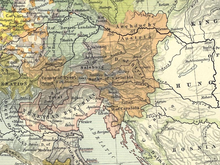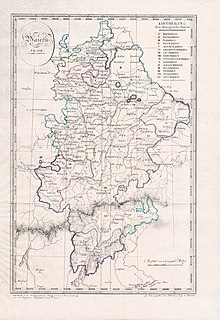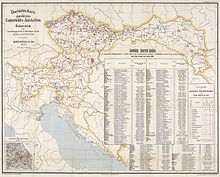Princely county of Tyrol
The Fürstete Grafschaft Tirol ( Italian contea principesca del Tirolo ) (until 1861 Fürstete Grafschaft Tirol with the state of Vorarlberg ) was a county in Central Europe , to which the region of Tyrol and until 1861 the state of Vorarlberg belonged. The provincial capitals were the cities of Meran (14th century – 1849) and Innsbruck (1849–1918).
The county emerged in the 11th century in the core area of Vinschgau - Burggrafenamt - Etschtal and reached into the Eisack and Inn valleys in the 12th and 13th centuries . From 1363 , apart from brief interruptions, it was owned by the Habsburgs and in 1804 became a crown land of the Austrian Empire and, from 1867, Austria-Hungary . After the First World War, the country was divided in the Treaty of Saint-Germain in 1919. The northern and eastern parts were assigned to the Republic of German Austria and today form the Austrian state of Tyrol . The southern part fell to the Kingdom of Italy and today consists of the two autonomous Italian provinces of Bolzano - South Tyrol and Trento .
history
Creation of the County of Tyrol
Local rulership around Castle Tyrol can be traced back to the 11th century.
From the 12th century, the Counts of Tyrol began to expand their territory to large parts of the region, surpassing the power of the bishops of Bressanone and Trento, who were nominally their feudal masters. After Heinrich the Proud gave up his rule as Bavarian Duke to Leopold in 1138 , the Counts of Tyrol strengthened their position against the previously nominal dependence on Bavaria.
Meinhardiner
In 1253 Meinhard I , Count of Görz since 1231 , inherited from the ruling dynasty of the Meinhardin Tyrol through his marriage to Adelheid, the daughter of the last local Tyrolean Count Albert III. of Tyrol and ruled from then on as Count of Tyrol and Gorizia. When his sons divided up his property after his death in 1271, his eldest son Meinhard II received control of Tyrol. As count, he supported the Roman-German King Rudolf von Habsburg against his rival King Ottokar II of Bohemia . As a reward he received the Duchy of Carinthia in 1286 .
In 1307 Meinhard's son Heinrich was elected King of Bohemia and ruled over Bohemia and Tyrol in personal union . His rule in Bohemia only lasted until 1310. After his death in 1335, his daughter Margarete took control of Tyrol and in 1342 married Ludwig V of Bavaria from the House of Wittelsbach .
When Ludwig V died in 1361, Margaret's son Meinhard III took over for a short time . rule for two years. When he died in 1363 without heirs, the House of Habsburg took over power in Tyrol with Rudolf IV . As counts, the Habsburgs retained Tyrol's independence. In the Treaty of Schärding in 1369, the Wittelsbachers recognized Tyrol as a possession of the Habsburgs.
Austrian and Bavarian rule

After the Treaty of Neuberg of September 25, 1379 had determined the division of the Habsburg hereditary lands , Tyrol was Duke Leopold III. slammed by Austria . After he fell in the battle of Sempach , his brother Albrecht III ruled . as guardian of his children, who were still underage, until his death in 1395. He was followed by Leopold IV for ten years . Under his successor Friedrich IV , Tyrol experienced a time of reforms, relative prosperity and expansion towards Venetian areas. In 1420 he made Innsbruck the new royal seat. In 1490 his son and heir Sigismund renounced Tyrol in favor of his cousin, the German King Maximilian I. Maximilian I thus reunited rule over the Habsburg lands under one rule. In 1500 he acquired the county of Gorizia and areas around Lienz and the Pustertal . In 1504 the Bavarian courts of Kufstein, Rattenberg and Kitzbühel went to Tyrol after the Landshut War of Succession . In the three named judicial districts, however, the land law of Ludwig of Bavaria continued to apply until the 19th century, so that they had a special legal position within Tyrol.
The Habsburg monarchs ruled in personal union over all areas of the house until the death of Emperor Ferdinand I in 1564. When he handed over the county to his son Ferdinand II , he ruled largely independently over Tyrol and bequeathed the rule to Maximilian III. Only after the death of Archduke Sigismund Francis in 1665 all Habsburg lands were again under the reign of Emperor Leopold I joined. During the War of the Spanish Succession in 1703, there was an ultimately unsuccessful invasion by Bavarian troops.
From the gubernators of the Habsburgs, Karl Philipp von der Pfalz ruled in Innsbruck from 1706–1717. During the reign of Maria Theresa of Austria (1740–1780), Tyrol was firmly tied to the central government in Vienna and remained so until 1861.
In 1803 the lands of the dioceses of Trento and Bressanone were secularized and incorporated into the county.
After the defeat of the Austrians in the Third Coalition War against France's ruler Napoleon in 1805, Austria was forced to cede Tyrol to the newly formed Kingdom of Bavaria in the Peace of Pressburg . As part of Bavaria, Tyrol became a member of the Rhine Confederation in 1806 . The Bavarian King Maximilian I Joseph carried out far-reaching economic, religious and administrative reforms. In 1808 a new constitution was drawn up for the Kingdom of Bavaria and Tyrol was declared a part of southern Bavaria. The country lost its previous autonomy. In addition, Tyroleans were drafted into the Bavarian army and were made subject to conscription . This, together with the economic decline under Bavarian rule, and the secular religious reforms in the kingdom, which were rejected by the Catholic population, led to a growing conflict between the Tyrolean population and the Bavarian authorities and resulted in the Tyrolean uprising by Andreas Hofer , who was violently crushed. (See also the Andreas-Hofer-Kreuzer of the Fürstete Grafschaft Tirol.)
In 1813/14 Tyrol was formally recaptured from Austria in the Sixth Coalition War and reunited with Austria in 1814 with the resolutions of the Congress of Vienna .
Crown land of the empires of Austria and Austria-Hungary

Since 1804, Tyrol as the Fürstete Grafschaft Tirol with the state of Vorarlberg was a crown land of the Austrian Empire . In April 1861 Vorarlberg was separated from Tyrol and became its own crown land.
With the political balance between the Austrian Empire and the Kingdom of Hungary , Tyrol became a crown land of the Austrian half of the empire . The relatively liberal and secular politics in Cisleithanien met resistance in Tyrol. In the Tyrolean Parliament clerical and conservative forces kept long in the majority. Nevertheless, Tyrol experienced a strong economic and cultural boom and remained loyal to the Danube monarchy.
With the beginning of the First World War in 1914, Italy made claims on the Trentino as compensation for its neutrality . Austria-Hungary put on delay and Italy signed the Treaty of London with the Entente on April 26, 1915 .
The war of Italy against the Austro-Hungarian monarchy began with the declaration of war on May 24, 1915. Tyrol then became the central theater of the mountain war from 1915 to 1918.
With the armistice of Villa Giusti on November 3, the southern half of Tyrol was occupied by Italian troops and the county was dissolved on November 11, 1918 with the declaration of renunciation by Emperor and King Charles I.
The subsequent German Republic of Austria confirmed the cession of South Tyrol to Italy in the 1919 Treaty of Saint-Germain . The north became a federal state of Austria. South Tyrol and Trentino initially received a very centralized administration and South Tyrol was Italianized during the time of the fascist regime . The two statutes of autonomy of 1948 and 1972 again granted the region certain powers of self-government.
The municipalities of Cortina d'Ampezzo , Buchenstein and Verseil , which were reclassified by Mussolini to the province of Belluno and in which a referendum in 2007 resulted in a majority in favor of the return to the province of Bolzano, as well as those of the fascists , are still excluded from the autonomy reclassified Trentino municipalities Pedemonte , Casotto (to the province of Vicenza ), Valvestino and Magasa (to the province of Brescia).
Politics and administration
With the February patent in 1861, Tyrol received its own elected state parliament and regional committee and became a partially sovereign member state of the Austro-Hungarian dual monarchy .
After the general and equal male suffrage was introduced in 1907, the state parliament had 96 members and the state committee six members. Tyrol also sent delegates to the Reichsrat in Vienna .
Administrative division
The Fürstete Grafschaft Tirol has been divided into 66 judicial districts and 23 political districts since 1849. The cities of Innsbruck , Bozen , Rovereto and Trento were autonomous cities.
Ruler
The rulers of Tyrol were provided by different dynasties. In the beginning still from local dynasties like the Meinhardins . The Bavarian Wittelsbachers and Habsburgs followed later .
Demographics
The population of Tyrol was 812,696 in 1890, 852,712 in 1900 and showed a slight increase of 0.5 percent annually. The population density in 1910 was 35.4 inhabitants per km² and for every 1000 males there were 1017 females. In 1900 the Tyrolean population was made up as follows:
| Ethnicity | population | percent |
|---|---|---|
| German | 461,000 | 55.6% |
| Italians (Welschtiroler) | 348,000 | 42.0% |
| Ladins | 20,000 | 2.4% |
The religious distribution was:
- Roman Catholic (approx. 810,000 inhabitants)
- Evangelical (2,200 inhabitants)
- Jewish (600 inhabitants)
economy
The economy of the County of Tyrol was mainly limited to forestry and cattle breeding due to the mountainous nature, but there was also little arable land. In South Tyrol, types of fruit such as wine, peaches, apricots, almonds, lemons (on Lake Garda), oranges, apples (especially near Bozen), pears, cherries and pomegranates were cultivated. Likewise the viticulture with a harvest of 866,502 hl.
One of the main sources of income for Tyrol is also cattle breeding. According to the 1900 census there were: 17,226 horses , 6,439 mules , mules and donkeys , 423,405 cattle , 176,594 sheep , 93,706 goats , 70,558 pigs and 50,468 beehives . The only notable industry in Tyrol was mining, with significant quantities of copper ore , iron ore , lead ore , zinc ore , pebbles , asphalt , lignite , peat , gypsum , chalk , quartz , marble , serpentine and amethysts being extracted .
The location of Tyrol between the German Empire and Italy proved to be advantageous for the transport system of the crown land. In 1900 there were 4831 km of country roads , 975 km of railways (944 km of which were main lines) and 339 km of waterways .
education
In Tyrol there was in 1900 a University of Innsbruck , 15 theological colleges , nine upper secondary schools, three upper secondary schools , six teachers 'training colleges , three girls' schools , four business schools, a state vocational school in Innsbruck, 16 industrial technical schools, a vocational training school, three schools for agriculture and forestry , a midwifery school, four music schools , two public, 1368 public and 55 private elementary schools .
See also
literature
- Ignatz de Luca: The Fürstete Graffschaft Tyrol. In: Geographisches Handbuch von dem Oestreichischen Staats. 2. Volume The countries in the Austrian district. Verlag Johannes Paul Krauss, Vienna 1790, pp. 335–502 ( Google eBook, full view ).
- Emil Werunsky: Austrian Empire and Legal History. (Section Tyrol). Vienna 1894.
Web links
Individual evidence
- ↑ Maria Corbi: E Cortina si risveglio in Sud Tirol: Una valanga di "si" al referendum ma spostare il confine non è facile e Brindisi pole miche per l'addio al simbolico Veneto . In: La Stampa . October 30, 2007, p. 22 ( lastampa.it ).
- ↑ European region: The way to more cooperation with Ladins in Belluno is open
- ^ Storia dei comuni
- ↑ Disegno di legge: Distacco del comune di Pedemonte dalla regione Veneto e sua aggregazione alla regione Trentino - Alto Adige / Sudtirol ai sensi dell'articolo 132, secondo comma, della Costituzione
- ↑ Disegno di legge: Distacco dei comuni di Valvestino e di Magasa dalla regione Lombardia e loro aggregazione alla regione Trentino-Alto Adige ai sensi dell'articolo 132, secondo comma, della Costituzione
- ↑ Lombardi shear Regional: Approvata Mozione 365 (14 April 2015)
- ↑ http://www.ancestrositalianos.com/italia/lista-comunas-italianas.html






